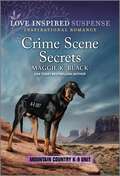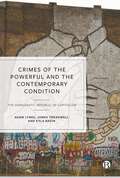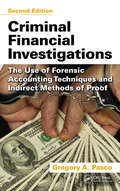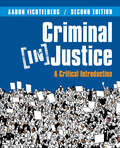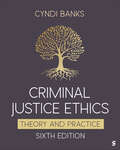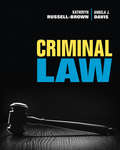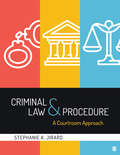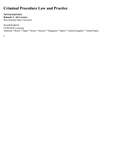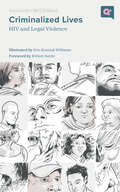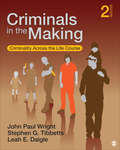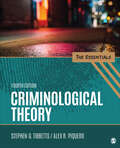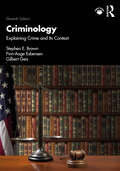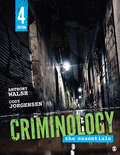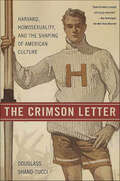- Table View
- List View
Crime Dynamics: Why Crime Rates Change Over Time (Elements in Criminology)
by null Richard RosenfeldThis Element reviews and augments research on changes over time in U.S. crime rates during the past several decades. Major topics include the data sources for studying crime trends; the relationship between homicide rates and rates of property crime, imprisonment, and firearm availability; trends in crime by sex, race, and age; the relationship between crime trends and economic conditions; crime trends and social institutions; abrupt changes in crime rates and exogenous shocks; forecasting crime rates; and the future of crime trends theory and research. The study of crime trends is as intellectually rewarding and practically important as any topic in criminology. But attracting scholars to this field of study of crime trends will require significant advancements in theory, methods, and policy application.
Crime Prevention: Programs, Policies, and Practices
by Steven E. Barkan Michael A. RocqueIn Crime Prevention: Programs, Policies, and Practices, criminologists Steven E. Barkan and Michael Rocque present a well-rounded exploration of evidence-based policies, programs, and practices. Grounded in criminological theory and emphasizing the social, psychological, and biological roots of crime, this text presents current research, perspectives, and examples that capture the key crime prevention concepts students should understand, including the public health model for crime prevention. Highlighting the importance of applying theory to real-world solutions, the authors′ discussion of crime prevention strategies integrates theory and practice throughout the text.
Crime Prevention: Programs, Policies, and Practices
by Steven E. Barkan Michael A. RocqueIn Crime Prevention: Programs, Policies, and Practices, criminologists Steven E. Barkan and Michael Rocque present a well-rounded exploration of evidence-based policies, programs, and practices. Grounded in criminological theory and emphasizing the social, psychological, and biological roots of crime, this text presents current research, perspectives, and examples that capture the key crime prevention concepts students should understand, including the public health model for crime prevention. Highlighting the importance of applying theory to real-world solutions, the authors′ discussion of crime prevention strategies integrates theory and practice throughout the text.
Crime Scene Secrets (Mountain Country K-9 Unit #4)
by Maggie K. BlackA wedding becomes a crime scene… now a K-9 team seeks a serial killer After shots are fired at a rehearsal dinner, FBI agent Kyle West arrives just in time to chase the gunman away. But attacks persist. Could this be the Rocky Mountain Killer—or a deadly copycat? Now Kyle and his K-9 partner must team up with investigator Ophelia Clarke to hunt down the shooter…before this wedding party becomes a mass murder. From Love Inspired Suspense: Courage. Danger. Faith.Mountain Country K-9 Unit Book 1: Baby Protection Mission by Laura ScottBook 2: Her Duty Bound Defender by Sharee StoverBook 3: Chasing Justice by Valerie HansenBook 4: Crime Scene Secrets by Maggie K. BlackBook 5: Montana Abduction Rescue by Jodie BaileyBook 6: Trail of Threats by Jessica R. PatchBook 7: Tracing a Killer by Sharon Dunn
Crimes in Southern Indiana: Stories
by Frank BillA ferocious debut that puts Frank Bill's southern Indiana on the literary map next to Cormac McCarthy's eastern Tennessee and Daniel Woodrell's Missouri OzarksCrimes in Southern Indiana is the most blistering, vivid, flat-out fearless debut to plow into American literature in recent years. Frank Bill delivers what is both a wake-up call and a gut punch. Welcome to heartland America circa right about now, when the union jobs and family farms that kept the white on the picket fences have given way to meth labs, backwoods gunrunners, and bare-knuckle brawling. Bill's people are pressed to the brink—and beyond. There is Scoot McCutchen, whose beloved wife falls terminally ill, leaving him with nothing to live for—which doesn't quite explain why he brutally murders her and her doctor and flees, or why, after years of running, he decides to turn himself in. In the title story, a man who has devolved from breeding hounds for hunting to training them for dog-fighting crosses paths with a Salvadoran gangbanger tasked with taking over the rural drug trade, but who mostly wants to grow old in peace. As Crimes in Southern Indiana unfolds, we witness the unspeakable, yet are compelled to find sympathy for the depraved. Bill's southern Indiana is haunted with the deep, authentic sense of place that recalls the best of Southern fiction, but the interconnected stories bristle with the urban energy of a Chuck Palahniuk or a latter-day Nelson Algren and rush with the slam-bang plotting of pulp-noir crime writing à la Jim Thompson. Bill's prose is gritty yet literary, shocking, and impossible to put down. A dark evocation of the survivalist spirit of the working class, this is a brilliant debut by an important new voice.
Crimes of the Powerful and the Contemporary Condition: The Democratic Republic of Capitalism
by James Treadwell Adam Lynes Kyla BavinThe ultimate expression of power is the ability to act beyond the confines of law, with contemporary society enabling elite groups to wield “panoramic power”. From the murderous crimes of the corporate giants that provide us with life’s luxuries and necessities to the data gathering activities of media and educational institutions, the authors offer new thinking on damaging structures of power and privilege. This accessible book provides a comprehensive understanding of elite corporate wrongdoing, and the late capitalist society that enables harm, considering both how we got into this mess and how we get out of it.
Criminal Financial Investigations: The Use of Forensic Accounting Techniques and Indirect Methods of Proof, Second Edition
by Dale L. June Gregory A. PascoUnderstanding the financial motivations behind white collar crime is often the key to the apprehension and successful prosecution of these individuals. Now in its second edition, this volume provides direct instruction on the how to aspects of criminal financial investigations, taking readers through the different approaches used in gathering evidence and demonstrating how to present circumstantial evidence to a judge or jury in a simple and convincing manner. Written by a former Special Agent with the Criminal Investigation Division of the U.S. Internal Revenue Service, the book sets out a methodology enabling readers to identify, pursue, and successfully prosecute white collar crime.
Criminal (In)Justice: A Critical Introduction
by Aaron FichtelbergCriminal (In)Justice: A Critical Introduction examines the American criminal justice system and the social forces that shape it. Using a conversational voice, the book challenges readers to consider the inequalities in the criminal justice system as well as in the broader society it is designed to protect, then ask, "What can I do to make this better?" Author Aaron Fichtelberg uses a unique, critical perspective to encourage students to look closer at the intersection of race, class, gender, and inequality in the criminal justice system. Covering each of the foundational areas of the criminal justice system—policing, courts, and corrections—this book takes an in-depth look at the influence of social inequality, making it ideal for instructors who want students to critically assess the American criminal justice system in a very approachable way. This second edition comes at a time when there is a profound awareness that the criminal justice system reflects deep and systematic inequalities in American society and has been updated to include some of these monumental changes. This title is accompanied by a complete teaching and learning package. Digital Option / Courseware SAGE Vantage is an intuitive digital platform that delivers this text’s content and course materials in a learning experience that offers auto-graded assignments and interactive multimedia tools, all carefully designed to ignite student engagement and drive critical thinking. Built with you and your students in mind, it offers simple course set-up and enables students to better prepare for class. LMS Cartridge (formerly known as SAGE Coursepacks): Import this title’s instructor resources into your school’s learning management system (LMS) and save time. Don’t use an LMS? You can still access all of the same online resources for this title via the password-protected Instructor Resource Site.
Criminal (In)Justice: A Critical Introduction
by Aaron FichtelbergCriminal (In)Justice: A Critical Introduction examines the American criminal justice system and the social forces that shape it. Using a conversational voice, the book challenges readers to consider the inequalities in the criminal justice system as well as in the broader society it is designed to protect, then ask, "What can I do to make this better?" Author Aaron Fichtelberg uses a unique, critical perspective to encourage students to look closer at the intersection of race, class, gender, and inequality in the criminal justice system. Covering each of the foundational areas of the criminal justice system—policing, courts, and corrections—this book takes an in-depth look at the influence of social inequality, making it ideal for instructors who want students to critically assess the American criminal justice system in a very approachable way. This second edition comes at a time when there is a profound awareness that the criminal justice system reflects deep and systematic inequalities in American society and has been updated to include some of these monumental changes. This title is accompanied by a complete teaching and learning package. Digital Option / Courseware SAGE Vantage is an intuitive digital platform that delivers this text’s content and course materials in a learning experience that offers auto-graded assignments and interactive multimedia tools, all carefully designed to ignite student engagement and drive critical thinking. Built with you and your students in mind, it offers simple course set-up and enables students to better prepare for class. LMS Cartridge (formerly known as SAGE Coursepacks): Import this title’s instructor resources into your school’s learning management system (LMS) and save time. Don’t use an LMS? You can still access all of the same online resources for this title via the password-protected Instructor Resource Site.
Criminal Justice Ethics: Theory and Practice
by Cyndi L. BanksCriminal Justice Ethics, Sixth Edition examines the criminal justice system through an ethical lens by identifying ethical issues in practice and theory, exploring ethical dilemmas, and offering suggestions for resolving ethical issues and dilemmas faced by criminal justice professionals. Bestselling author Cyndi Banks draws readers into a unique discussion of ethical issues by exploring moral dilemmas faced by professionals in the criminal justice system before examining the major theoretical foundations of ethics. This distinct organization allows readers to understand real life ethical issues before grappling with philosophical approaches to the resolution of those issues.
Criminal Justice Ethics: Theory and Practice
by Cyndi L. BanksCriminal Justice Ethics, Sixth Edition examines the criminal justice system through an ethical lens by identifying ethical issues in practice and theory, exploring ethical dilemmas, and offering suggestions for resolving ethical issues and dilemmas faced by criminal justice professionals. Bestselling author Cyndi Banks draws readers into a unique discussion of ethical issues by exploring moral dilemmas faced by professionals in the criminal justice system before examining the major theoretical foundations of ethics. This distinct organization allows readers to understand real life ethical issues before grappling with philosophical approaches to the resolution of those issues.
Criminal Law
by Katheryn Russell-Brown Angela J. DavisAn Interdisciplinary Approach Criminal Law provides students with an integrated framework for understanding the U.S. criminal justice system with a diverse and inclusive interdisciplinary approach and thematic focus. Authors Katheryn Russell-Brown and Angela J. Davis go beyond the law and decisions in court cases to consider and integrate issues of race, gender, and socio-economic status with their discussion of criminal law. Material from the social sciences is incorporated to highlight the intersection between criminal law and key social issues. Case excerpts and detailed case summaries, used to highlight important principles of criminal law, are featured throughout the text. The coverage is conceptual and practical, showing students how the criminal law applies in the "real world"—not just within the pages of a textbook.
Criminal Law
by Katheryn Russell-Brown Angela J. DavisAn Interdisciplinary Approach Criminal Law provides students with an integrated framework for understanding the U.S. criminal justice system with a diverse and inclusive interdisciplinary approach and thematic focus. Authors Katheryn Russell-Brown and Angela J. Davis go beyond the law and decisions in court cases to consider and integrate issues of race, gender, and socio-economic status with their discussion of criminal law. Material from the social sciences is incorporated to highlight the intersection between criminal law and key social issues. Case excerpts and detailed case summaries, used to highlight important principles of criminal law, are featured throughout the text. The coverage is conceptual and practical, showing students how the criminal law applies in the "real world"—not just within the pages of a textbook.
Criminal Law and Procedure: A Courtroom Approach
by Stephanie A. JirardWritten by a former federal prosecutor and public defender, Criminal Law and Procedure: A Courtroom Approach introduces students to the essentials of criminal law and procedure by illuminating the legal issues justice professionals face before, during, and after a criminal trial. Through the examination of statutes, edited case excerpts, and recent constitutional interpretation of black letter law, the text bridges the gap between learning criminal procedure and applying criminal law. Drawing from author Stephanie A. Jirard’s vast experience in both the courtroom and the classroom, Criminal Law and Procedure gets students to think critically about real-world issues and practice applying the law in a just and meaningful way. Accessible and engaging, this text presents criminal law and procedure as an exciting opportunity to have a direct, positive impact on our communities and the criminal justice system. Key Features: "Making the Courtroom Connection" boxes help students apply the legal concepts they learn to real-life issues facing law enforcement, the court system, and correctional institutions today. Edited case excerpts connect criminal law and procedure with current case material on relevant topics so students can see the impact of judicial decision making. "Applying the Law to the Facts" boxes engage students’ critical thinking skills and enhance their logical problem-solving abilities by providing opportunities to apply the rule of law to different scenarios. "Springboard for Discussion" prompts spark conversations and invite students to contrast the moral, ethical, and legal implications of criminal law and procedure in a larger context. Problem-solving exercises at the end of each chapter provide students with opportunities to test themselves on the material before a formal assessment. Active Learning Exercises in the Instructor’s Manual enable professors to offer additional opportunities for experiential learning. Give your students the SAGE edge! SAGE edge offers a robust online environment featuring an impressive array of free tools and resources for review, study, and further exploration, keeping both instructors and students on the cutting edge of teaching and learning.
Criminal Law and Procedure: A Courtroom Approach
by Stephanie A. JirardWritten by a former federal prosecutor and public defender, Criminal Law and Procedure: A Courtroom Approach introduces students to the essentials of criminal law and procedure by illuminating the legal issues justice professionals face before, during, and after a criminal trial. Through the examination of statutes, edited case excerpts, and recent constitutional interpretation of black letter law, the text bridges the gap between learning criminal procedure and applying criminal law. Drawing from author Stephanie A. Jirard’s vast experience in both the courtroom and the classroom, Criminal Law and Procedure gets students to think critically about real-world issues and practice applying the law in a just and meaningful way. Accessible and engaging, this text presents criminal law and procedure as an exciting opportunity to have a direct, positive impact on our communities and the criminal justice system. Key Features: "Making the Courtroom Connection" boxes help students apply the legal concepts they learn to real-life issues facing law enforcement, the court system, and correctional institutions today. Edited case excerpts connect criminal law and procedure with current case material on relevant topics so students can see the impact of judicial decision making. "Applying the Law to the Facts" boxes engage students’ critical thinking skills and enhance their logical problem-solving abilities by providing opportunities to apply the rule of law to different scenarios. "Springboard for Discussion" prompts spark conversations and invite students to contrast the moral, ethical, and legal implications of criminal law and procedure in a larger context. Problem-solving exercises at the end of each chapter provide students with opportunities to test themselves on the material before a formal assessment. Active Learning Exercises in the Instructor’s Manual enable professors to offer additional opportunities for experiential learning. Give your students the SAGE edge! SAGE edge offers a robust online environment featuring an impressive array of free tools and resources for review, study, and further exploration, keeping both instructors and students on the cutting edge of teaching and learning.
Criminal Procedure: Law And Practice
by Rolando V. Del CarmenPacked with examples from real-world situations faced by today's law enforcement professionals, CRIMINAL PROCEDURE: LAW AND PRACTICE, 9e gives you a practical and authoritative look at the most current guidelines in criminal procedure. Comprehensive and accurate without bogging you down in unnecessary details, the text includes cutting-edge coverage of the law on arrests, searches and seizures, vehicle stops, use of force, interrogations, and line-ups. It also discusses current topics on racial profiling, DNA evidence, plea bargaining, seizures of text/email messages, technology, the USA Patriot Act, and much more. Long known for its relevance to law enforcement, it features interesting case briefs, sample police forms, hypothetical cases, and coverage of the most recent Supreme Court rulings.
Criminalized Lives: HIV and Legal Violence (Q+ Public)
by Alexander McClellandCanada has been known as a hot spot for HIV criminalization where the act of not disclosing one’s HIV-positive status to sex partners has historically been regarded as a serious criminal offence. Criminalized Lives describes how this approach has disproportionately harmed the poor, Black and Indigenous people, gay men, and women in Canada. In this book, people who have been criminally accused of not disclosing their HIV-positive status, detail the many complexities of disclosure, and the violence that results from being criminalized. Accompanied by portraits from artist Eric Kostiuk Williams, the profiles examine whether the criminal legal system is really prepared to handle the nuances and ethical dilemmas faced everyday by people living with HIV. By offering personal stories of people who have faced criminalization first-hand, Alexander McClelland questions common assumptions about HIV, the role of punishment, and the violence that results from the criminal legal system’s legacy of categorizing people as either victims or perpetrators. Note: A regrettable error appears on page 22. The number 240 should be 206 when referring to the number of people prosecuted in relation to allegations of HIV nondisclosure. This will be fixed in future reprints.
Criminals in the Making: Criminality Across the Life Course
by Stephen G. Tibbetts Leah E. Daigle John Paul WrightWhy do individuals exposed to the same environment turn out so differently, with some engaging in crime and others abiding by societal rules and norms? Why are males involved in violent crime more often than females? And why do the precursors of serious pathological behavior typically emerge in childhood? This fascinating text addresses key questions surrounding criminal propensity by discussing studies of the life-course perspective—criminological research that links biological factors associated with criminality with the social and environmental agents thought to cause, facilitate, or otherwise influence a tendency towards criminal activity. The book provides comprehensive, interdisciplinary coverage of the current thinking in the field about criminal behavior over the course of a lifetime. Additionally, it highlights interventions proven effective and illustrates how the life-course perspective has contributed to a greater understanding of the causes of crime.
Criminals in the Making: Criminality Across the Life Course
by Stephen G. Tibbetts Leah E. Daigle John Paul WrightWhy do individuals exposed to the same environment turn out so differently, with some engaging in crime and others abiding by societal rules and norms? Why are males involved in violent crime more often than females? And why do the precursors of serious pathological behavior typically emerge in childhood? This fascinating text addresses key questions surrounding criminal propensity by discussing studies of the life-course perspective—criminological research that links biological factors associated with criminality with the social and environmental agents thought to cause, facilitate, or otherwise influence a tendency towards criminal activity. The book provides comprehensive, interdisciplinary coverage of the current thinking in the field about criminal behavior over the course of a lifetime. Additionally, it highlights interventions proven effective and illustrates how the life-course perspective has contributed to a greater understanding of the causes of crime.
Criminological Theory: The Essentials
by Stephen G. Tibbetts Alex R. PiqueroCriminological Theory: The Essentials, Fourth Edition by Stephen G. Tibbetts and Alex R. Piquero is a brief yet comprehensive overview of the major concepts and perspectives of the key theories in the evolution of criminology. Putting criminological theory in context, the acclaimed authors examine policy implications brought about by theoretical perspectives to show students the practical application of theories to contemporary social problems. The new edition has been thoroughly updated with the latest theoretical extensions and empirical research, with links made to specific theories and recent events.
Criminological Theory: The Essentials
by Stephen G. Tibbetts Alex R. PiqueroCriminological Theory: The Essentials, Fourth Edition by Stephen G. Tibbetts and Alex R. Piquero is a brief yet comprehensive overview of the major concepts and perspectives of the key theories in the evolution of criminology. Putting criminological theory in context, the acclaimed authors examine policy implications brought about by theoretical perspectives to show students the practical application of theories to contemporary social problems. The new edition has been thoroughly updated with the latest theoretical extensions and empirical research, with links made to specific theories and recent events.
Criminology: Explaining Crime and Its Context
by Finn-Aage Esbensen Gilbert Geis Stephen E. BrownCriminology: Explaining Crime and Its Context, Eleventh Edition, offers a broad perspective on criminological theory. It provides students of criminology, criminal justice, and sociology with a thorough exposure to a range of theories about crime, contrasting their logic and assumptions, but also highlighting efforts to integrate and blend these frameworks.In this new edition, the authors have incorporated new directions that have gained traction in the field, while remaining faithful to their criminological heritage. Among the themes in this work are the relativity of crime (its changing definition) with abundant examples, historical roots of criminology and the lessons they have provided, and the strength and challenges of applying the scientific method. This revision offers new chapters on critical theory and on life-course criminology. It is updated throughout to reflect current trends in criminological theory and data.With chapters both updated to reflect recent developments in the field and made easier to digest, this text is essential reading for students of criminology, criminal justice, sociology, and related fields.
Criminology: The Essentials
by Anthony Walsh Cody JorgensenAnthony Walsh and Cody Jorgensen’s Criminology: The Essentials introduces students to major theoretical perspectives and topics in a concise, easy-to-read format. This straightforward overview of key subject areas in criminology thoroughly covers the most up-to-date advances in theory and research while challenging students to consider the applications of these theories and their policy implications. The Fourth Edition includes new topics, events, and developments in criminology.
Criminology: The Essentials
by Anthony Walsh Cody JorgensenAnthony Walsh and Cody Jorgensen’s Criminology: The Essentials introduces students to major theoretical perspectives and topics in a concise, easy-to-read format. This straightforward overview of key subject areas in criminology thoroughly covers the most up-to-date advances in theory and research while challenging students to consider the applications of these theories and their policy implications. The Fourth Edition includes new topics, events, and developments in criminology.
The Crimson Letter: Harvard, Homosexuality, and the Shaping of American Culture
by Douglass Shand-TucciIn a book deeply impressive in its reach while also deeply embedded in its storied setting, bestselling historian Douglass Shand-Tucci explores the nature and expression of sexual identity at America's oldest university during the years of its greatest influence. The Crimson Letter follows the gay experience at Harvard in the nineteenth and twentieth centuries, focusing upon students, faculty, alumni, and hangers-on who struggled to find their place within the confines of Harvard Yard and in the society outside.Walt Whitman and Oscar Wilde were the two dominant archetypes for gay undergraduates of the later nineteenth century. One was the robust praise-singer of American democracy, embraced at the start of his career by Ralph Waldo Emerson; the other was the Oxbridge aesthete whose visit to Harvard in 1882 became part of the university's legend and lore, and whose eventual martyrdom was a cautionary tale. Shand-Tucci explores the dramatic and creative oppositions and tensions between the Whitmanic and the Wildean, the warrior poet and the salon dazzler, and demonstrates how they framed the gay experience at Harvard and in the country as a whole.The core of this book, however, is a portrait of a great university and its community struggling with the full implications of free inquiry. Harvard took very seriously its mission to shape the minds and bodies of its charges, who came from and were expected to perpetuate the nation's elite, yet struggled with the open expression of their sexual identities, which it alternately accepted and anathematized. Harvard believed it could live up to the Oxbridge model, offering a sanctuary worthy of the classical Greek ideals of male association, yet somehow remain true to its legacy of respectable austerity and Puritan self-denial.The Crimson Letter therefore tells stories of great unhappiness and manacled minds, as well as stories of triumphant activism and fulfilled promise. Shand-Tucci brilliantly exposes the secrecy and codes that attended the gay experience, showing how their effects could simultaneously thwart and spark creativity. He explores in particular the question of gay sensibility and its effect upon everything from symphonic music to football, set design to statecraft, poetic theory to skyscrapers.The Crimson Letter combines the learned and the lurid, tragedy and farce, scandal and vindication, and figures of world renown as well as those whose influence extended little farther than Harvard Square. Here is an engrossing account of a university transforming and transformed by those passing through its gates, and of their enduring impact upon American culture.


